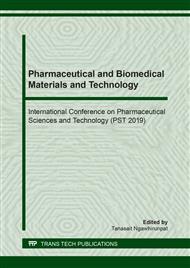p.98
p.104
p.111
p.118
p.124
p.130
p.139
p.145
p.151
Biological Activities and Dermal Penetration of Liposome-Containing Coprinus atramentraris Extract
Abstract:
The total phenolic content and antioxidant activities of five edible mushrooms (Pleurotus djamor, Agaricus bisporus, Hericlum erinaceus, Coprinus atramentraris and P. ostreatus) were evaluated. The Coprinus atramentraris ethanolic extract (CE) showed the promising antioxidant property and had a strong relationship with phenolic compound content. Liposome-containing CE formulations, were prepared with various lipid composition. The liposome formulation, L1, which composed of phospholipids and cholesterol at ratio of 6:4 gave the highest entrapment efficiency (24.03%), small particle size (143.03 nm) and favorable particle size distribution (0.311) with small values of zeta potential (-30.2 mV). L1 showed good anti-elastase property (IC50 0.029) and no cytotoxicity effect to the human skin fibroblasts and melanoma cells even at the highest concentration of 1 mg/mL compared to the unformulated extract. The in vitro skin permeation studies, using human cadaver skin and modified Franz-diffusion cells, showed that the L1 was able to considerably increase the rate of permeation of phenolic compounds in L1 compared to the CE solution. These results reflect the use of L1 as active agents in cosmeceuticals.
Info:
Periodical:
Pages:
124-129
Citation:
Online since:
August 2019
Authors:
Price:
Сopyright:
© 2019 Trans Tech Publications Ltd. All Rights Reserved
Share:
Citation:


